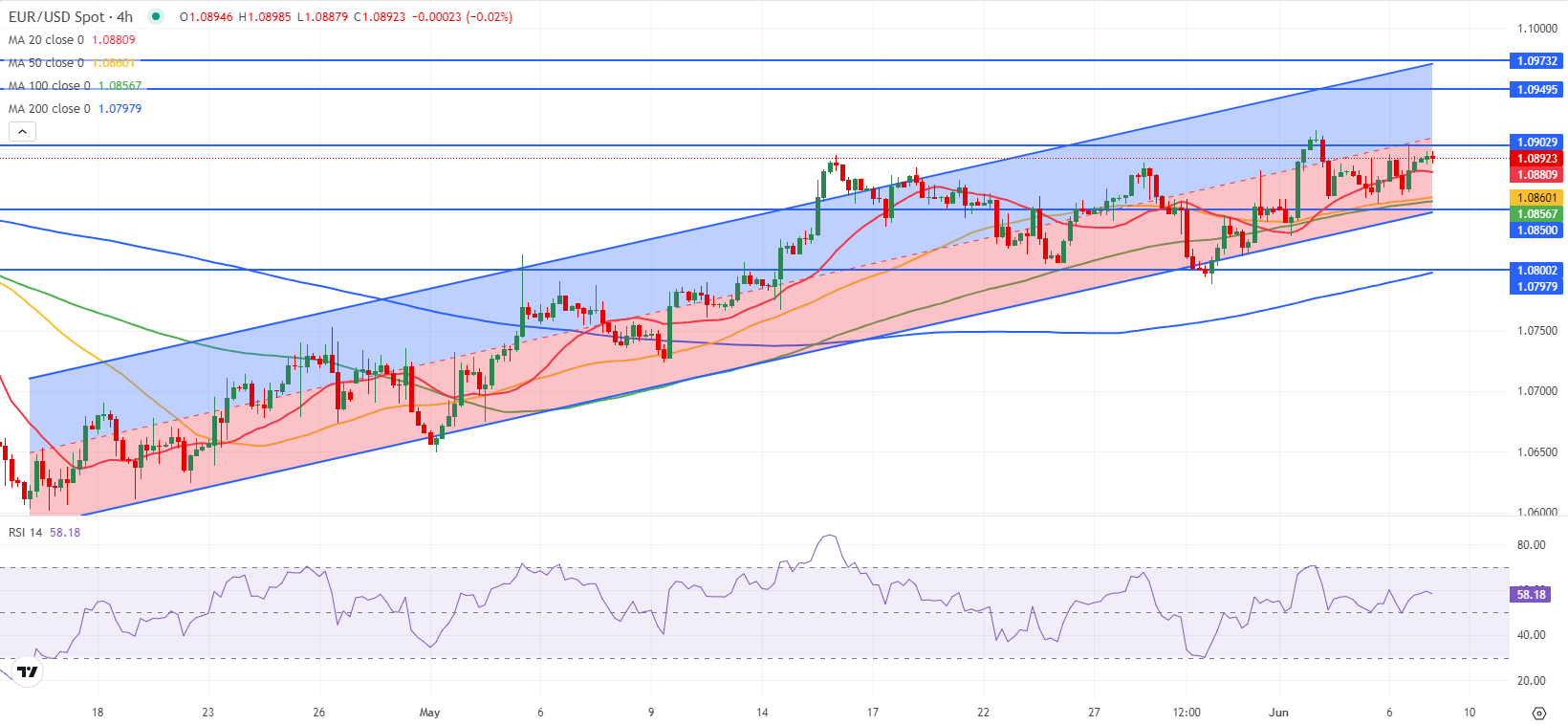- EUR/USD holds steady at around 1.0900 in the European morning.
- The ECB raised key rates by 25 basis points as expected.
- Nonfarm Payrolls in the US are forecast to rise 185K in May.
EUR/USD registered small gains on Thursday and stabilized at around 1.0900 in the early European session on Friday. May labor market data from the US could ramp up the market volatility heading into the weekend.
The European Central Bank (ECB) announced on Thursday that it raised its key rates by 25 basis points following the June policy meeting, as expected. In the post-meeting press conference, ECB President Christine Lagarde refrained from confirming additional rate cuts and reiterated the data-dependent approach moving forward.
Euro PRICE This week
The table below shows the percentage change of Euro (EUR) against listed major currencies this week. Euro was the strongest against the Canadian Dollar.
| USD | EUR | GBP | JPY | CAD | AUD | NZD | CHF | |
|---|---|---|---|---|---|---|---|---|
| USD | -0.41% | -0.41% | -1.21% | 0.30% | -0.34% | -0.96% | -1.57% | |
| EUR | 0.41% | 0.03% | -0.78% | 0.71% | -0.05% | -0.55% | -1.18% | |
| GBP | 0.41% | -0.03% | -0.76% | 0.68% | -0.01% | -0.64% | -1.21% | |
| JPY | 1.21% | 0.78% | 0.76% | 1.48% | 0.93% | 0.39% | -0.21% | |
| CAD | -0.30% | -0.71% | -0.68% | -1.48% | -0.66% | -1.25% | -1.87% | |
| AUD | 0.34% | 0.05% | 0.01% | -0.93% | 0.66% | -0.51% | -1.16% | |
| NZD | 0.96% | 0.55% | 0.64% | -0.39% | 1.25% | 0.51% | -0.66% | |
| CHF | 1.57% | 1.18% | 1.21% | 0.21% | 1.87% | 1.16% | 0.66% |
The heat map shows percentage changes of major currencies against each other. The base currency is picked from the left column, while the quote currency is picked from the top row. For example, if you pick the Euro from the left column and move along the horizontal line to the US Dollar, the percentage change displayed in the box will represent EUR (base)/USD (quote).
Early Friday, several ECB policymakers adopted a cautious tone on further easing but voiced their optimism about the inflation outlook, making it difficult for the Euro to find direction.
ECB policymakers Kazaks and Muller warrant caution on further rate cuts.
ECB’s Nagel: ECB isn't on autopilot on interest-rate cuts.
ECB's de Guindos: Inflation is to be around 2% next year.
In the second half of the day, the US Bureau of Labor Statistics will release the jobs report for May. Nonfarm Payrolls (NFP) are expected to rise 185,000 following the weaker-than-forecast 175,000 increase recorded in April. Ahead of next week's Federal Reserve policy meeting, the market reaction to labor market data could be straightforward but remain short-lived.
In case NFP surprises to the upside with an increase of more than 200,000, the US Dollar (USD) could hold its ground ahead of the weekend and make it difficult for EUR/USD to stretch higher. On the other hand, a disappointing print, at or below 150,000, could trigger a fresh leg of USD selloff and provide a boost to the pair. If the data arrives near analysts' estimates, revisions to previous reading and the wage inflation figures could drive the USD's valuation. On a yearly basis, Average Hourly Earnings are forecast to rise 3.9%.
EUR/USD Technical Analysis
EUR/USD faces immediate resistance at 1.0900, where the mid-point of the ascending regression channel is located. If the pair rises above this level and starts using it as support, it could target 1.0950 (static level) and 1.0980 (upper limit of the ascending channel) next.
On the downside, 1.0860-1.0850 (50-period Simple Moving Average (SMA) on the 4-hour chart, 100-period SMA, lower limit of the ascending channel) aligns as key support before 1.0800 (200-period SMA, static level).
Nonfarm Payrolls FAQs
Nonfarm Payrolls (NFP) are part of the US Bureau of Labor Statistics monthly jobs report. The Nonfarm Payrolls component specifically measures the change in the number of people employed in the US during the previous month, excluding the farming industry.
The Nonfarm Payrolls figure can influence the decisions of the Federal Reserve by providing a measure of how successfully the Fed is meeting its mandate of fostering full employment and 2% inflation. A relatively high NFP figure means more people are in employment, earning more money and therefore probably spending more. A relatively low Nonfarm Payrolls’ result, on the either hand, could mean people are struggling to find work. The Fed will typically raise interest rates to combat high inflation triggered by low unemployment, and lower them to stimulate a stagnant labor market.
Nonfarm Payrolls generally have a positive correlation with the US Dollar. This means when payrolls’ figures come out higher-than-expected the USD tends to rally and vice versa when they are lower. NFPs influence the US Dollar by virtue of their impact on inflation, monetary policy expectations and interest rates. A higher NFP usually means the Federal Reserve will be more tight in its monetary policy, supporting the USD.
Nonfarm Payrolls are generally negatively-correlated with the price of Gold. This means a higher-than-expected payrolls’ figure will have a depressing effect on the Gold price and vice versa. Higher NFP generally has a positive effect on the value of the USD, and like most major commodities Gold is priced in US Dollars. If the USD gains in value, therefore, it requires less Dollars to buy an ounce of Gold. Also, higher interest rates (typically helped higher NFPs) also lessen the attractiveness of Gold as an investment compared to staying in cash, where the money will at least earn interest.
Nonfarm Payrolls is only one component within a bigger jobs report and it can be overshadowed by the other components. At times, when NFP come out higher-than-forecast, but the Average Weekly Earnings is lower than expected, the market has ignored the potentially inflationary effect of the headline result and interpreted the fall in earnings as deflationary. The Participation Rate and the Average Weekly Hours components can also influence the market reaction, but only in seldom events like the “Great Resignation” or the Global Financial Crisis.
Information on these pages contains forward-looking statements that involve risks and uncertainties. Markets and instruments profiled on this page are for informational purposes only and should not in any way come across as a recommendation to buy or sell in these assets. You should do your own thorough research before making any investment decisions. FXStreet does not in any way guarantee that this information is free from mistakes, errors, or material misstatements. It also does not guarantee that this information is of a timely nature. Investing in Open Markets involves a great deal of risk, including the loss of all or a portion of your investment, as well as emotional distress. All risks, losses and costs associated with investing, including total loss of principal, are your responsibility. The views and opinions expressed in this article are those of the authors and do not necessarily reflect the official policy or position of FXStreet nor its advertisers. The author will not be held responsible for information that is found at the end of links posted on this page.
If not otherwise explicitly mentioned in the body of the article, at the time of writing, the author has no position in any stock mentioned in this article and no business relationship with any company mentioned. The author has not received compensation for writing this article, other than from FXStreet.
FXStreet and the author do not provide personalized recommendations. The author makes no representations as to the accuracy, completeness, or suitability of this information. FXStreet and the author will not be liable for any errors, omissions or any losses, injuries or damages arising from this information and its display or use. Errors and omissions excepted.
The author and FXStreet are not registered investment advisors and nothing in this article is intended to be investment advice.
Recommended Content
Editors’ Picks

EUR/USD recovers toward 1.0600 as US Dollar retreats ahead of data
EUR/USD extends the rebound toward 1.0600 in the European session on Friday. The renewed upside is mainly linked to a broad US Dollar pullback as traders look to the topt-tier US Retail Sales data for a fresh impetus. ECB- and Fedspeak also eyed.

GBP/USD holds above 1.2650 after UK data
GBP/USD holds its recovery momentum above 1.2650 in European trading on Friday. The mixed UK GDP and industrial data fail to deter Pound Sterling buyers as the US Dollar rally takes a breather ahead of Retail Sales and Fedspeak.

Gold stabilizes after bouncing off 100-day moving average
Gold trades little changed on Friday, holding steady in the $2,560s after making a slight recovery from the two-month lows reached on the previous day. A stronger US Dollar continues to put pressure on Gold since it is mainly priced and traded in the US currency.

Bitcoin to 100k or pullback to 78k?
Bitcoin and Ethereum showed a modest recovery on Friday following Thursday's downturn, yet momentum indicators suggest continuing the decline as signs of bull exhaustion emerge. Ripple is approaching a key resistance level, with a potential rejection likely leading to a decline ahead.

Trump vs CPI
US CPI for October was exactly in line with expectations. The headline rate of CPI rose to 2.6% YoY from 2.4% YoY in September. The core rate remained steady at 3.3%. The detail of the report shows that the shelter index rose by 0.4% on the month, which accounted for 50% of the increase in all items on a monthly basis.

Best Forex Brokers with Low Spreads
VERIFIED Low spreads are crucial for reducing trading costs. Explore top Forex brokers offering competitive spreads and high leverage. Compare options for EUR/USD, GBP/USD, USD/JPY, and Gold.
